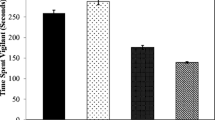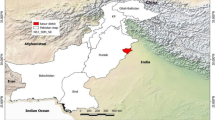Summary
Rufous-naped wrens (Campylorhynchus rufinucha) in northwestern Costa Rica build breeding nests most frequently in ant-acacia trees (Acacia collinsii) and occasionally near wasp nests in ant-acacia trees. By moving occupied wasp nests (Polybia rejecta) to randomly chosen ant-acacia trees with wren nests, I tested the hypothesis that wrens nesting near wasp nests were more likely to fledge young than wrens not nesting near wasp nests. Wrens whose nests were near experimentally relocated wasp nests were significantly more likely to fledge young (37.5% of 16 attempts in 1987 and 75% of 12 attempts in 1988) than were wrens whose nests had no wasp nests placed near them (0% of 16 attempts in 1987 and 20% of 15 attempts in 1988). In 15 cases, repeated nesting attempts occurred in the same trees both with and without experimentally-placed wasp nests. Analysis of these data allowed a comparison of the effect of wasp nests on fledging success while differences among trees were controlled. Within the same tree, nesting attempts associated with wasp nests were significantly more likely to fledge young than nesting attempts without wasp nests. Predation was the primary cause of nest failure, and within forest, white-faced monkeys (Cebus capucinus) were the most important predators. The difference in success of wren nests with and without wasps and observations of predators indicate that enhancement of fledging success was due to deterrence of predatory vertebrates by wasps.
Similar content being viewed by others
References
Arnold KA (1966) The avian genus Thryothorus (Troglodytidae) in Costa Rica: A study in species diversity. Unpublished PhD dissertation, Louisiana State University, Baton Rouge LA
Austad SN, Rabenold KN (1985) Reproductive enhancement by helpers and an experimental inquiry into its mechanism in the bicolored wren. Behav Ecol Sociobiol 17:19–28
Austad SN, Rabenold KN (1986) Demography and the evolution of cooperative breeding in the bicolored wren, Campylorhynchus griseus. Behaviour 97:308–324
Chadab R (1980) Army-ant predation on social wasps. Unpublished PhD dissertation, University of Connecticut, Storrs CT
Collias NE, Collias EC (1984) Nest building and bird behavior. Princeton University Press, Pinceton NJ
Freed LA (1987) Rufous-and-white wrens kill house wren nestlings during a food shortage. Condor 89:195–197
Gosse PH (1847) Birds of Jamaica. John Van Voorst, London
Hindwood KA (1955) Bird/wasp nesting associations. Emu 55:263–274
Janzen DH (1966) Coevolution of mutualism between ants and acacias in Central America. Evolution20:249–275
Janzen DH (1967) Interaction of the bull's-horn acacia (Acacia cornigera L.) with an ant inhabitant (Pseudomyrmex ferruginea F. Smith) in eastern Mexico. Univ Kans Sci Bull 47:315–558
Janzen DH (1969) Birds and the ant x acacia interaction in Central America, with notes on birds and other myrmecophytes. Condor 71:240–256
Janzen DH (1986) Guanacaste National Park: ecological and cultural restoration. Editorial Universidad Estatal a Distancia, San Jose, Costa Rica
Janzen DH (1988) Ecological characterization of a Costa Rican dry forest caterpillar fauna. Biotropica 20:120–135
Jeanne RL (1975) The adaptiveness of social wasp nest architecture. Q Rev Biol 50:267–287
Joyce FJ (1990) Nesting associations of birds, ants, and wasps. Unpublished PhD dissertation, Cornell University, Ithaca, NY
Moreau RE (1942) The nesting of African birds in association with other living things. Ibis 85:240–263
Myers JG (1929) The nesting-together of birds, wasps and ants. Proc R Entomol Soc London 4:80–88
Myers JG (1935) Nesting associations of birds with social insects. Trans Entomol Soc London 83:11–22
Overal WL, Simões D, Gobbi N (1981) Colony defense and sting autotomy in Polybia rejecta (Hymenoptera: Vespidae). Rev Brasil Entomol 25:41–47
Pimentel RA, Smith JD (1985) BIOSTAT I. Sigma Soft, Placentia CA
Rabenold KN (1984) Cooperative enhancement of reproductive success in tropical wren societies. Ecology 65:871–885
Richards OW (1978) The social wasps of the Americas excluding the Vespinae. Brit Mus (Nat Hist), London, p 580
Ricklefs RE (1969) An analysis of nesting mortality in passerine birds. Smithson Contrib Zool 9:1–48
Robinson SK (1985) Coloniality in the yellow-rumped cacique as a defense against nest predators. Auk 102:506–519
Robinson SK (1986) Competitive and mutualistic interactions among females in a neotropical oriole. Anim Behav 34:113–122
Selander RK (1964) Speciation in wrens of the genus Campylorhynchus. Univ Calif Publ Zool 74:1–305
Siegel S, Castellan NJ Jr (1988) Nonparametric statistics for the behavioral sciences. McGraw-Hill, New York, NY
Skutch AF (1940) Social and sleeping habits of Central American wrens. Auk57:293–312
Skutch AF (1960) Life histories of Central American birds II. Pacific Coast Avifauna, no. 34 Berkeley: Cooper Ornithological Society
Skutch AF (1976) Parent birds and their young. University of Texas Press, Austin TX
Skutch AF (1985) Clutch size, nesting success, and predation on nests of neotropical birds, reviewed. In: Buckley PA, Foster MS, Morton ES, Ridgely RS, and Buckley FG (eds) Neotropical ornithology. Ornithol Monogr 36:575–594
Slud P (1964) The birds of Costa Rica, distribution and ecology. Bulletin of the American Museum of Natural History, New York, vol. 128
Smith NG (1968) The advantage of being parasitized. Nature 219:690–694
Smith NG (1983) Zarhynchus wagleri. In: Janzen DH (ed) Costa Rican natural history. University of Chicago Press, Chicago IL, pp 614–616
Stiles FG, Skutch AF (1989) A guide to the birds of Costa Rica. Cornell University Press, Ithaca NY
Strahl SD (1985) The behavior and socio-ecology of the hoatzin, Opisthocomus hoazin, in the Ilanos of Venezuela. Unpublished PhD dissertation, State University of New York at Albany, Albany NY
Strahl SD (1988) The social organization and behaviour of the hoatzin Opisthocomus hoazin in central Venezuela. Ibis 130:483–502
Vehrencamp S, Stiles FG, Bradbury J (1977) Observations on the foraging behavior and avian prey of the Neotropical carnivorious bat, Vampyrum spectrum. J Mammal 58:469–478
Ward PS (1989) Systematic studies on pseudomyrmecine ants: revision of the Pseudomyrmex oculatus and P. subtilissimus species groups with taxonomic comments on other species. Questiones Entomol 25:393–468
Wiley H (1983) Campylorhynchus rufinucha. In: Janzen DH (ed) Costa Rican natural history. University of Chicago Press, Chicago IL, pp 558–560
Windsor DM (1983) Polybia occidentalis. In: Janzen DH (ed) Costa Rican natural history. University of Chicago Press, Chicago IL, pp 760–762
Wunderle JM, Pollock KH (1985) The bananaquit-wasp nesting association and a random choice model. In: Buckley PA, Foster MS, Morton ES, Ridgely RS, and Buckley FG (eds) Neotropical Ornithology. Ornithol Monogr 36, pp 595–603
Young BE, Kaspari M, Martin TE (1990) Species-specific nest site selection by birds in ant-acacia trees. Biotropica 22:310–315
Author information
Authors and Affiliations
Rights and permissions
About this article
Cite this article
Joyce, F.J. Nesting success of rufous-naped wrens (Campylorhynchus rufinucha) is greater near wasp nests. Behav Ecol Sociobiol 32, 71–77 (1993). https://doi.org/10.1007/BF00164038
Received:
Accepted:
Issue Date:
DOI: https://doi.org/10.1007/BF00164038




